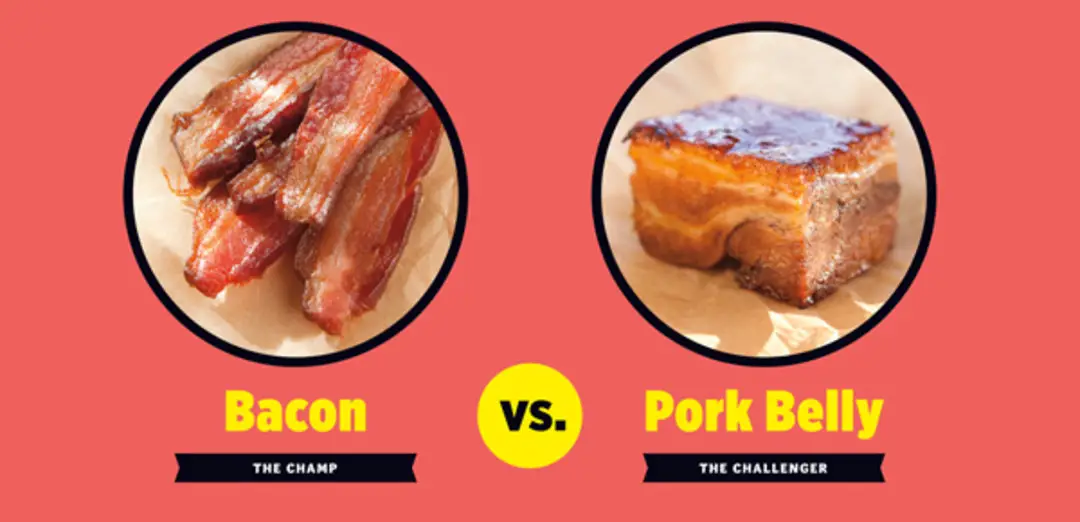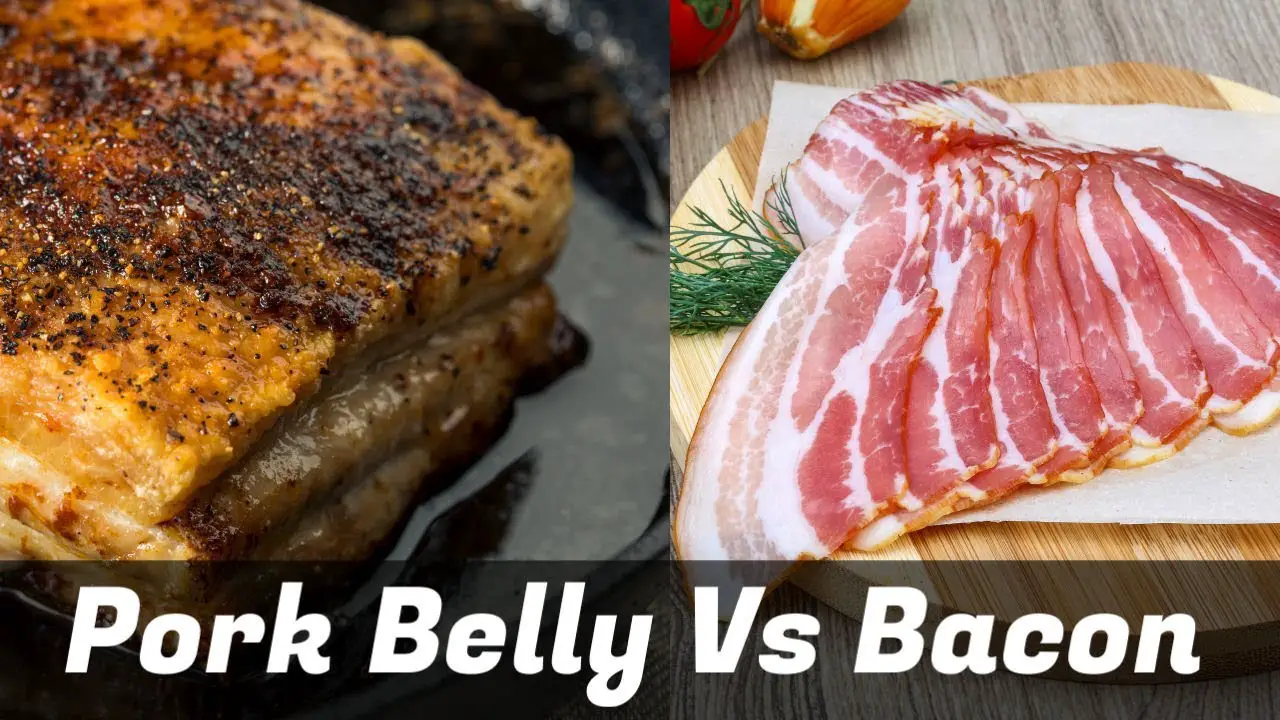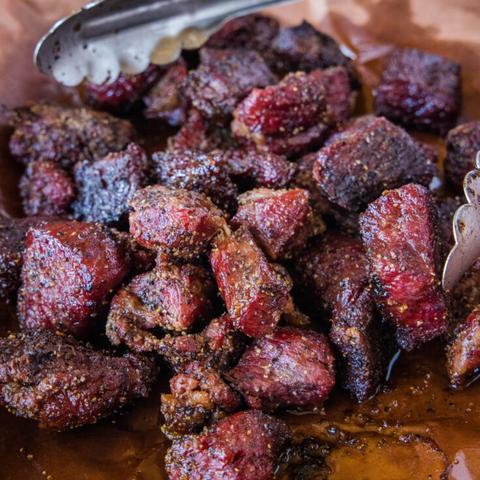
“Pork Belly vs Bacon: Unraveling the Delicious Debate. Dive into the sizzling world of pork belly and bacon as we explore their differences, flavors, and cooking techniques. Discover which one reigns supreme on your plate, whether you crave tender succulence or crispy indulgence. Get ready to tantalize your taste buds with this savory showdown!”
Pork Belly vs Bacon: What’s the Difference?

Pork belly and bacon are both popular cuts of meat, but they have some key differences. Pork belly is sourced from the belly of a pig and is uncured, while bacon is primarily made from pork belly but can also be cut from other parts of the pig such as the back, loin, jowls, sides, pork butt, and shoulder. Bacon goes through a curing process where it is salted and seasoned before being smoked with hardwood. On the other hand, pork belly is not smoked or cured. Both cuts can be used in a variety of recipes and are known for their tender and flavorful qualities.
One important distinction between pork belly and bacon is their health implications. Bacon contains higher levels of nitrites and sodium due to the curing process, which can contribute to health issues like high blood pressure, heart disease, and clogged arteries. In comparison, pork belly does not contain any additives or require excessive salting. However, it does tend to have more fat when sold as a slab. When cooking pork belly or bacon, it’s important to properly prepare them to avoid rubbery or tough textures.
Pork Belly and Bacon Compared
Pork belly and bacon are both popular cuts of meat that come from pigs, but there are some key differences between the two. Pork belly is sourced from the belly of the pig and is uncured, meaning it has not undergone a salting and seasoning process. It is often used in a variety of recipes and can be cooked in a deep fryer, braised, or roasted. Pork belly is known for its tender texture and soft fattiness.
Bacon, on the other hand, is primarily made from pork belly but can also be derived from other parts of the pig such as the back, loin, jowls, sides, pork butt, and shoulder. Bacon goes through a curing process where it is salted to draw out moisture. After curing, bacon is typically dried and then smoked with hardwood like apple or cherry wood. Bacon is usually eaten as a slice of meat with breakfast or used as a filling in sandwiches.
While both pork belly and bacon have their own unique qualities and uses in cooking, bacon tends to be higher priced due to its longer processing time and added additives such as sodium and nitrites. Pork belly is considered healthier since it does not contain these additives, although it may have large amounts of fat if untrimmed. Both pork belly and bacon can be cooked in various ways but should be properly prepared to achieve desired textures.
What is Pork Belly?
Pork belly is a cut of meat that comes from the belly of a pig. It is uncured, meaning it has not been treated with salt or other additives like bacon. This cut is known for its tenderness and soft fattiness, which gives it a melt-in-your-mouth texture when cooked. Pork belly can be purchased in regular grocery stores or as a full slab from local butchers. It is versatile and can be used in various recipes, including deep frying, braising, or roasting.
Unlike bacon, which can be derived from different cuts of pork such as back, loin, jowls, sides, pork butt, and shoulder, pork belly specifically refers to the cut from the pig’s belly. It does not undergo the curing process like bacon does. Pork belly can be considered healthier than bacon since it does not contain nitrites or excessive amounts of sodium. However, it is important to note that untrimmed pork belly may have large amounts of fat and may still have the skin on it.

What Cut is Bacon?
Bacon can be cut from various parts of the pig’s body, including the belly, back, loin, jowls, sides, pork butt, and shoulder. In the United States, bacon is exclusively made from the belly cut. However, in countries outside of the US, it can sometimes be difficult to determine exactly where a cut of bacon was derived from on the pig. The specific cuts used for bacon may be labeled differently depending on the region or country.
The process of making bacon involves salting and seasoning these different cuts of pork through a process called “curing.” Curing involves using salt to draw moisture out of the meat. The curing process typically takes 5-7 days for pork belly. Afterward, the cure mixture is removed from the cut and it is dried for 6-24 hours. Finally, it is smoked with a hardwood such as apple or cherry wood. It’s important to note that although bacon is cured or processed, it still needs to be cooked prior to eating to prevent any bacteria from causing illness.
The Differences Between Pork Belly and Bacon?
Pork belly and bacon may seem similar, but there are distinct differences between these two cuts of meat. Pork belly is sourced from the belly of a pig, while bacon can be derived from various parts of the pig such as the back, loin, jowls, sides, pork butt, and shoulder. Pork belly is typically uncured and used in a variety of recipes, while bacon undergoes a curing process where it is salted to draw out moisture.
Another difference lies in the cooking methods. Pork belly is often cooked in a deep fryer, braised, or roasted to achieve its tender and melt-in-your-mouth texture. On the other hand, bacon is usually fried until crisp or nearly crisp. Additionally, pork belly tends to have the skin still on it, which can give it a rind that may not be pleasant to chew.
In terms of health considerations, pork belly is generally considered healthier than bacon because it does not undergo curing and does not contain additives like sodium nitrites. However, pork belly can be high in fat if not trimmed properly. Bacon, with its higher levels of nitrites and sodium due to the curing process, is often considered less healthy.
In conclusion, while both pork belly and bacon come from the same cut of meat, they differ in terms of preparation, flavor, and versatility. Pork belly is a fatty and tender cut that can be cooked in various ways to create rich flavors, while bacon is cured and smoked to produce its distinctive taste. Both have their unique qualities and are enjoyed in different dishes around the world. Ultimately, the choice between pork belly and bacon depends on personal preference and the desired outcome in a recipe.
Learn More About Grilling
If you want to learn more about grilling, check out these other helpful resources!











